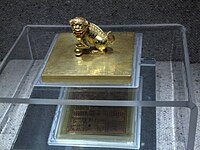Names of Vietnam
| History of Vietnam (Names of Vietnam) |

| ||||||||||||||||||||||||||||||||||||||||||||||||||||||
|---|---|---|---|---|---|---|---|---|---|---|---|---|---|---|---|---|---|---|---|---|---|---|---|---|---|---|---|---|---|---|---|---|---|---|---|---|---|---|---|---|---|---|---|---|---|---|---|---|---|---|---|---|---|---|---|
| |||||||||||||||||||||||||||||||||||||||||||||||||||||||
Throughout the history of Vietnam, many names were used in reference to Vietnam.
History[]

Throughout the history of Vietnam, official and unofficial names have been used in reference to the territory of Vietnam. Vietnam was called Văn Lang during the Hùng Vương Dynasty, Âu Lạc under King An Dương king, Nam Việt during the Triệu Dynasty, Van Xuan during the Anterior Lý Dynasty, Đại Cồ Việt during the Đinh dynasty and Early Lê dynasty. Starting in 1054, Vietnam was called Đại Việt (Great Viet).[1] During the Hồ dynasty, Vietnam was called Đại Ngu.[2]
Việt Nam (![]() listen in Vietnamese) is a variation of Nam Việt (Southern Việt), a name that can be traced back to the Triệu dynasty (2nd century BC, also known as Nanyue Kingdom).[3] The word "Việt" originated as a shortened form of Bách Việt, a word used to refer to a people who lived in what is now southern China in ancient times. The word "Việt Nam", with the syllables in the modern order, first appears in the 16th century in a poem by Nguyễn Bỉnh Khiêm. "Annam", which originated as a Chinese name in the seventh century, was the common name of the country during the colonial period. Nationalist writer Phan Bội Châu revived the name "Vietnam" in the early 20th century. When rival communist and anti-communist governments were set up in 1945, both immediately adopted this as the country's official name. In English, the two syllables are usually combined into one word, "Vietnam". However, "Viet Nam" was once common usage and is still used by the United Nations and by the Vietnamese government.
listen in Vietnamese) is a variation of Nam Việt (Southern Việt), a name that can be traced back to the Triệu dynasty (2nd century BC, also known as Nanyue Kingdom).[3] The word "Việt" originated as a shortened form of Bách Việt, a word used to refer to a people who lived in what is now southern China in ancient times. The word "Việt Nam", with the syllables in the modern order, first appears in the 16th century in a poem by Nguyễn Bỉnh Khiêm. "Annam", which originated as a Chinese name in the seventh century, was the common name of the country during the colonial period. Nationalist writer Phan Bội Châu revived the name "Vietnam" in the early 20th century. When rival communist and anti-communist governments were set up in 1945, both immediately adopted this as the country's official name. In English, the two syllables are usually combined into one word, "Vietnam". However, "Viet Nam" was once common usage and is still used by the United Nations and by the Vietnamese government.
Origin of Vietnam[]



The term "Việt" (Yue) (Chinese: 越; pinyin: Yuè; Cantonese Yale: Yuht; Wade–Giles: Yüeh4; Vietnamese: Việt) in Early Middle Chinese was first written using the logograph "戉" for an axe (a homophone), in oracle bone and bronze inscriptions of the late Shang dynasty (c. 1200 BC), and later as "越".[4] At that time it referred to a people or chieftain to the northwest of the Shang.[5] In the early 8th century BC, a tribe on the middle Yangtze were called the Yangyue, a term later used for peoples further south.[5] Between the 7th and 4th centuries BC Yue/Việt referred to the State of Yue in the lower Yangtze basin and its people.[4][5]
From the 3rd century BC the term was used for the non-Chinese populations of south and southwest China and northern Vietnam, with particular states or groups called Minyue, Ouyue, Luoyue (Vietnamese: Lạc Việt), etc., collectively called the Baiyue (Bách Việt, Chinese: 百越; pinyin: Bǎiyuè; Cantonese Yale: Baak Yuet; Vietnamese: Bách Việt; "Hundred Yue/Viet"; ).[4][5] The term Baiyue/Bách Việt first appeared in the book Lüshi Chunqiu compiled around 239 BC.[6]
In 207 BC, former Qin dynasty general Zhao Tuo/Triệu Đà founded the kingdom Nanyue/Nam Việt (Chinese: 南越; "Southern Yue/Việt") with its capital at Panyu (modern Guangzhou). This kingdom was "southern" in the sense that it was located south of other Baiyue kingdoms such as Minyue and Ouyue, located in modern Fujian and Zhejiang. Several later Vietnamese dynasties followed this nomenclature even after these more northern peoples were absorbed into China.
In 968, the Vietnamese leader Đinh Bộ Lĩnh established the independent kingdom of Đại Cồ Việt (大瞿越) (possibly meaning "Great Gautama's Viet", as Gautama's Hanzi transcription 瞿曇 is pronounced Cồ Đàm in Sino-Vietnamese);[7][8] however, 瞿's homophone cồ,